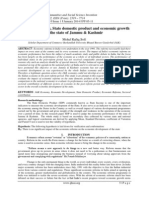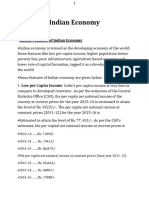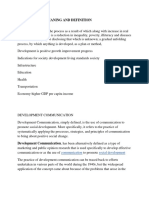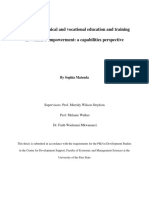jkeconomy
jkeconomy
Uploaded by
bjoshita05Copyright:
Available Formats
jkeconomy
jkeconomy
Uploaded by
bjoshita05Copyright
Available Formats
Share this document
Did you find this document useful?
Is this content inappropriate?
Copyright:
Available Formats
jkeconomy
jkeconomy
Uploaded by
bjoshita05Copyright:
Available Formats
© 2017 IJEDR | Volume 5, Issue 4 | ISSN: 2321-9939
Economic Features of Jammu And Kashmir Economy
Dr Sutinder singh
Lecturer GDC Bijbehare Ant. J&K
_______________________________________________________________________________________________________
Abstract - The state of J&K is rich in natural resources, but due to its economic and technological backwardness, the
optimum utilization of resources has not been made possible so far. In fact, underutilization of natural resources has been
one of the major causes of economic backwardness and poverty of the state. The state is rich in natural resources such as
land, forests, water and minerals and its climate is suitable for the establishment of many important industrial activities
such as manufacturing of silk, cotton and woolen textiles, chemicals, etc, but in spite of this, the state has failed miserably
to make the best use of these resources for the betterment and upliftment of the people. No doubt, some areas of land
which had been left uncultivated have been brought under cultivation, but still there are vast tracks of land in different
regions of the state which are yet to be brought under cultivation. At present, the state is importing huge quantities of food
grains and other agricultural products from other states of the country. To attain self-sufficiency in these products, the
state should increase agricultural production by bringing more and more land under cultivation. The present paper will
highlight all the features of J&K economy.
Keywords - Economy, Employment, Features, Jammu and Kashmir, Per-capita Income Etc.
________________________________________________________________________________________________________
Introduction
Jammu And Kashmir State is one amongst the low per capita income states of country. In terms of per capita income, its rank has
never gone beyond 6th position in the Indian union. The growth of income has also been much more less than at the national
level. Despite, the recent drastic reduction in absolute poverty a significant proportion of people is still sub survive in a meager
income. Most of the natural resources particularly water; minerals and forest recourses remain untapped and unutilized. There is
hardly any large scale industry present in the state. Physical infrastructure particularly road connectivity is very poor. At the level
of human resources development state continues to be deficit in thriving entrepreneur’s class. Political insatiability and Terrorism
has been a big hindrance for the domestic and foreign investors. The collapse of traditional physical infrastructure particularly
road links has given a serious set-back to trade and commerce of the state. Last, but not least the state of Jammu and Kashmir is
not a homogenous region in terms of geographical features and cultural characteristics.
Objectives
➢ To study the various features of the Jammu and Kashmir economy.
➢ To study the hindrances which are actually facing the Jammu and Kashmir economy
Methodology
The study is based upon secondary resources of information which we have collected from:
➢ Reports, journals, magazines and newspapers.
➢ Economic census.
➢ Annual survey of industries.
➢ Digest of statistics government of J&K.
➢ Economic survey Etc.
FEATURES OF JAMMU AND KASHMIR ECONOMY
The following are the main economic features of Jammu and Kashmir economy:-
• Low per Capita Income
Developing economies are marked by the existence of low per capita income. The per capita income of J&K economy at current
prices in 2005-2006 was $ 582 whereas at all India level it was $ 720. It was maximum in Chandigarh in Indian union which was
$ 24253 and it was $ 220 in Bihar which was lowest in the Indian union.
• Occupational Pattern
One of the basic characteristics of under developed economies is that it is a primary producing economy. A very high proportion
of working population is engaged in agriculture which contributes a very large share in the national income. In Jammu and
Kashmir economy in 2005-2006 about 75% of the population derives its livelihood directly and indirectly from the agricultural
sector. Whereas the share of agriculture and allied sectors in the Net State Domestic Product (at 1980-1981 prices) for the year
2005-2006 as per advanced estimates stands at 30.88%. In Asia, Africa and Middle East economies from 2/3rds (66%) to more
than 4/5th (80%) of the population earn their livelihood from the agriculture and in most Latin American economies from 2/3rds
(66%) to 3/4ths (75%) of population are dependent on agriculture. It is evident that the proportion of population engaging
agriculture in developed economies is much more less than the proportion of population engaged in agriculture in under
developed economies like ours Jammu and Kashmir economy.
• Heavy Population Pressure
The Jammu and Kashmir state with an area of 138 thousand Sq.Kms and a population of 1.00069 crores (census 2001) occupies
the 6th place in respect of area and 19th place in respect of population among the states of India. The decades growth rate of
population according to census 2001 was 29.04% in J&K economy even this is higher than the country’s population growth rate
IJEDR1704091 International Journal of Engineering Development and Research (www.ijedr.org) 578
© 2017 IJEDR | Volume 5, Issue 4 | ISSN: 2321-9939
of 21.34%. The fast rate of growth rate of population necessitates a higher rate of economic growth in order to maintain the same
standard of living of population. To maintain a rapidly growing population the requirement of food, clothing, shelter, medicine,
schooling, etc all rise. Thus, a rise in population imposes greater economic burdens and consequently society has to make a much
greater effort to initiate the process of growth.
• Unemployment
The state of J&K has been facing the problem of unemployment for long and became a major cause of concern for the
government as per the findings of 62nd round of NSS (July 2005-June 2006) report unemployment rate in respect of Jammu and
Kashmir state has been worked out at 5.2% (5.4% for males and 3.5% for females) which is on higher side when compared to all
India figures of 3.1% (3.1% for males and 3.0% for females) as per Usual Principle Status. The basic and fundamental reasons for
unemployment in Jammu and Kashmir economy are:-
➢ The mounting pressure of population which is increasing at an alarming rate.
➢ In J&K economy unemployment is structural and is result of a deficiency of capital. The J&K economy does not find
sufficient capital to expand its industries to such an extent that the entire labour force is absorbed.
• Wide Spread of Poverty
The most important feature of the Jammu and Kashmir Economy is the general poverty among the people. Low income is the
cause of low standard of living entailing miseries and hardships to the people. The Net State Domestic Product per capita was
estimated at Rs. 16086 in 2005 at constant prices (1980-81). The Net domestic Product per capita of the country as a whole was
Rs. 20734 in the same year at same prices. The intensity of the problem of poverty in the state can be imagined from the fact that
India has the lowest per capita income in the community of nations and the per capita income of the state of Jammu and Kashmir
is even lower than the national average income. Excepting of course, a negligible, fraction of the society, people are generally
poor. They are ill-fed, ill-clothed and ill-housed. Under-nourishment tells upon their health and efficiency. The total BPL
estimated population ratio of Jammu and Kashmir economy has been arrived at 21.63% (24.21 lakh persons) with a dispersion of
26.14% (22 lakh persons) for rural areas and 7.9% (2.21 lakh persons) for urban areas in 2005 as per the BPL survey conducted in
2008 by the Directorate of Economics and Statistics. Besides, there are large income inequalities in the state. The per capita
income of the state has increased from Rs. 1776 in 1980-81 at constant prices (1980-81) to Rs. 16086 in 2005-06 at same prices,
but still it is too low to enable the people to cope with the lower possible standard of living
• Low rate of capital formation
Capital plays a significant role in economic development of a country. Capital is the backbone of economic development so much
so that economic development cannot take place without a sufficient rate of capital formation. In India, the rate of capital
formation is very low. Low income and wasteful consumption are the main causes of low levels of savings and investment in the
country. What is true of the country as a whole is also true of the state of Jammu and Kashmir. Unfortunately, however, no
reliable data is available in this field. But it is widely believed that the rate of capital formation in Jammu and Kashmir is much
lower than the rates of capital formation in many other states of the country. The low rate of economic growth in Jammu and
Kashmir is the result of low rate of capital formation and the state cannot advance economically unless the rate of capital
formation is increased
• Low Level of Living of Average of J&K People
Failure to secure a balanced diet manifests in J&K economy in the low calorie intake and low level of consumption of proteins. In
1999, the average calorie intake of food is only 2496 as compared to over 3400 calories per day in most of the developed
countries. This is slightly above the minimum intake for sustaining life estimated at 2100 calories. Since, nearly 21.63% of the
population in J&K lived below the poverty line in 2005, it is very doubtful whether the poor get a minimum intake of even 2100
calories.
• Demographic Characteristics of J&K Economy
Among the demographic characteristics associated with under development is high density of population. Besides this, the
average expectation of life is low and infant mortality rates are high. It would be proper to examine these characteristics of J&K
Economy. The density of population in J&K economy is 100 per sq.km. As compared with this the average density of population
in the world is 50 per sq.km in 2005.However, In India the density of population is 324, in Canada &Australia, and it is barely 3
persons per sq.km. The infant mortality rate in 2005 in J&K economy is 51 where as it is 55 at all India level. The expectation of
life at birth in J&K economy is 63 Years where as it is 63.8 years at all India level in 2005. 2.4.9. Poor Quality of Human Capital
The human development index is based on life expectancy, literacy rate and the real GDP per capita income. The value of HDI in
J&K economy was 0.337 in 1981 and it increased to 0.42 in 1991. This shows that the HDI value of J&K Economy increases, but
marginally.
• Prevalence of Low Level of Technology
The application of primitive methods and outmoded techniques in production is one of the important causes of low productivity in
the industrial sectors of the Jammu and Kashmir economy. The need and importance of the use of modern techniques of
production have not been realized and consequently, productivity per worker in the industrial concerns of the state could not be
increased. Low rate of capital formation and scarcity of technically trained personnel do not allow the state to employ the most
modern methods and use the sophisticated machines in production. Besides, the trade unions have also been opposing the
introduction of labour saving machines in the industrial sector of the state economy. The state Government also seems of the state
economy. The State government also seems to have preferred labour intensive technique to capital intensive technique of
production in the public sector industrial units with a view to absorb more and more job seekers. In the presence of sizeable
unemployment and cheap labour available in the state, it is of course advisable to go in for labour intensive technique of
production. However, the modern methods of production must be applied wherever necessary and unless this is done, the goals of
improvement in productivity, rapid industrialization and overall economic development cannot be accomplished, Besides, proper
IJEDR1704091 International Journal of Engineering Development and Research (www.ijedr.org) 579
© 2017 IJEDR | Volume 5, Issue 4 | ISSN: 2321-9939
training must be imparted to the workers of the industrial concerns, especially in the public sector, to make them familiar with the
application of modern technology in production.
Problems
The state of J&K is industrially more backward than many other states of country due to a number of reasons such as:
• Poor Resource Management
• Political instability.
• Deficiency of capital.
• Shortage of daring and dynamic entrepreneurs and
• Inadequate attention paid by the state government to industrial development of the state.
• Terrorism
• Mismanagement Etc
➢ Poor Resource Management
The State has a chronic problem of lack of funds available to it, for the past 50 years the State of J&K did not have a culture to
pay dues that belonged to ‘Caesar’! Tax collection has been dismal; there is institutional cynicism in the ability of the State to
gather its claimed resources, and the administration has only the ability to pay salaries to its over bloated bureaucracy with no
resources left in funds to undertake developmental activities, except that which is prompted by Central assistance through grants
in aid, or soft loans.
➢ Political Instability
Political instability set back to investment both domestic and foreign investments which intern lead to un-exploitation of huge
natural resources for which the state of J&K is known for . Political instability also channeled the local investment into real estate
rather than into productive sectors like agricultural and industrial sector. Political instability, since 1990’s has led to huge
diversion of resources from productive sectors to the maintenance of law and order problems. Whatever, worthwhile physical
infrastructure in terms of schools, buildings, bridges and various other administrative offices were seriously damaged. Therefore,
with political instability industrial development becomes slow down.
➢ Deficiency of Capital
Capital plays a significant role in economic development of a country. Capital is the backbone of economic development so much
so that economic development can’t take place without a sufficient rate of capital formation. In India, the rate of capital formation
is very low. Low income and wasteful consumption are the main causes of low levels of savings and investment is the country.
What is true of the country as a whole is also true of the state of J&K. Unfortunately; however, no reliable data is available in this
field. But, it is widely believed that the rate of capital formation in Jammu and Kashmir is much lower than the rates of capital
formation in many other states of the country. The low rate of economic growth in J&K economy is the result of low rate of
capital formation and the state can’t advance economically unless the rate of capital formation is increased.
➢ Shortage of Entrepreneurial Abilities
It is known fact that entrepreneurs play a vital role in economic development. According to Schumpeter, it is the entrepreneur
who takes the responsibility of advancing the economy economically through experiment and innovation. Indeed, no economy
can achieve any tangible success in the field of development unless daring and dynamic entrepreneurs come forward and play
positive role in up lifting the economy through experiment, discoveries and innovations. Unfortunately, the state of J&K lacks
entrepreneurial abilities.
➢ Inadequate Attention Paid by the State Government to Industrial Development of the State
It is now widely accepted fact that it is the responsibility of the state to provide necessary infrastructure for industrial
development. The state has to start new industrial units and invest more in those industrial concerns which do not attract private
investment. The public sector in the state of J&K has to play a vital role in improving the performance of its own industrial units.
Besides, it has also to provide tangible facilities to induce private investors to expand their units on the one hand and start new
ones on the other.
Conclusion
The state of J&K is more backward than many other states of the country. Various indicators show that the state is for away from
the goal of industrial and over-all economic development. At present, all the features of underdeveloped economy are present in
the J&K economy. For example; inadequate infrastructure, low per capita income, general poverty among the people, low
agricultural and industrial productivity, too much dependence on agriculture, low rate of industrial growth, use of outdated
technology, existence of sizeable unemployment and regional disparities are the dominant features of the state economy. These
are also the features of an underdeveloped economy. Keeping in view what has been said above, it is suggested that the state Govt
should take steps immediately to remove all the obstacles to rapid industrialization and over-all economic development. The state
should reduce its expenditure on unproductive items and the resources released therefore should be utilized for the developmental
programmes.
Bibliography
[1] Amit–Bhadur (2006): Employment Opportunities and Economic policy, Oxford University.
[2] Aggarwal, J. C. and S. P. Agarwal (1995): Modern History of Jammu and Kashmir, Vol- I; Concept publishing house, New
Delhi.
[3] Agha, Sayed and P.C. Rao (1960): Cooperative Movement in Jammu and Kashmir, The J&K cooperative union Ltd., Jammu
[4] Anand, A. S. (1980): The department of The Constitution of Jammu and Kashmir; Light and Life publishers, Jammu
[5] Atkinson, Edward T. (1973): The Himalayan Gazette; Cosmos publications, Delhi.
IJEDR1704091 International Journal of Engineering Development and Research (www.ijedr.org) 580
© 2017 IJEDR | Volume 5, Issue 4 | ISSN: 2321-9939
[6] Bamzai, P. N. K. (1965): Culture and Political History of Kashmir – Medieval Kashmir, Vol -II; M D publications Pvt. Ltd.,
New Delhi
[7] Basu, D. D. (1965): Commentary on the Constitution of India, Vol. II.
[8] Bhatt, R.K. Koul (1984): Political and Constitutional Development of Jammu and Kashmir State; Seema publications, Delhi.
[9] Chandran India‟s Economy (a survey of current economic problems) publishing house Cosmos bookhive ltd. New Delhi
110028
[10] Charak, SDS (1985): Life and Times of Maharaja Rambir Singh; Jay Kay Book House, Jammu.
[11] Charak, SDS (2002): Jammu Kingdom-History & Culture of Himalayan States, Vol-IX; Jay Kay Book House, Jammu.
[12] Charak, SDS (1979): Kirpa Ram’s Gulabnama (English translation); Light and life Publishers, New Delhi
[13] Chib, Sukhdev Singh (1977): This Beautiful India- Jammu and Kashmir; Light and life publisher, Jammu.
[14] Cunningham, A. (1970): Ladakh- Physical, Stastical and Historical with Notes of the Surrounding Countries; Sagar
Publications, New Delhi.
IJEDR1704091 International Journal of Engineering Development and Research (www.ijedr.org) 581
You might also like
- MPRA_paper_48570Document43 pagesMPRA_paper_48570ranakdalai91No ratings yet
- Indian Economic Development (Robust Economy With Tattering MassesDocument7 pagesIndian Economic Development (Robust Economy With Tattering MassesOm Prakash Yadav100% (1)
- Sectors Contributing To India's GDPDocument5 pagesSectors Contributing To India's GDPachala24_shahNo ratings yet
- Impact of The NREGP On Rural Livelihoods Amir Ullah Khan and M R SalujaDocument30 pagesImpact of The NREGP On Rural Livelihoods Amir Ullah Khan and M R Salujadd_pacNo ratings yet
- Ie PDFDocument913 pagesIe PDFMehul JainNo ratings yet
- International Journal of Humanities and Social Science Invention (IJHSSI)Document7 pagesInternational Journal of Humanities and Social Science Invention (IJHSSI)inventionjournalsNo ratings yet
- Economic Development of Bangladesh: Munich Personal Repec ArchiveDocument9 pagesEconomic Development of Bangladesh: Munich Personal Repec ArchiveDk jrNo ratings yet
- Indian Economy-Facts On India GDPDocument4 pagesIndian Economy-Facts On India GDPNirag ShahNo ratings yet
- Unit 13 PDFDocument23 pagesUnit 13 PDFcsgidlabllpgidyrekNo ratings yet
- The Bright Side of GlobalizationDocument2 pagesThe Bright Side of GlobalizationBhavesh JainNo ratings yet
- Indian Economy - 3Document9 pagesIndian Economy - 3zbpoetNo ratings yet
- Economics Module - II-1Document70 pagesEconomics Module - II-1Neet 720No ratings yet
- Class 9 Social Science Economics Chapter 3 Poverty as a challenge (1)Document3 pagesClass 9 Social Science Economics Chapter 3 Poverty as a challenge (1)binoyzrarsignsNo ratings yet
- National Income: The Study of National Income Is Important Because of The Following ReasonsDocument3 pagesNational Income: The Study of National Income Is Important Because of The Following ReasonsClementFernandesNo ratings yet
- 8 Major Problems Faced by The Indian EconomyDocument8 pages8 Major Problems Faced by The Indian EconomyrakeshNo ratings yet
- According To World Bank, Poverty Is Pronounced Deprivation inDocument5 pagesAccording To World Bank, Poverty Is Pronounced Deprivation inDevyani Joshi 11 'A'No ratings yet
- Population Growth and Its ImpactDocument3 pagesPopulation Growth and Its ImpactAshis Kumar MohapatraNo ratings yet
- JBMA 13 020mohajanDocument9 pagesJBMA 13 020mohajanManjare Hassin RaadNo ratings yet
- Role of Agriculture in Economic Development in IndiaDocument26 pagesRole of Agriculture in Economic Development in IndiaAnuj Jaiswal100% (2)
- Manonmaniam Sundaranar University: B.A. Economics - Iii YearDocument196 pagesManonmaniam Sundaranar University: B.A. Economics - Iii Yearsidhantamahakul19No ratings yet
- Assignment On INDIAN EconomyDocument16 pagesAssignment On INDIAN Economyprithvi yadavNo ratings yet
- Introduction of EOPDocument5 pagesIntroduction of EOPasadasfprp2No ratings yet
- Broad Profile of The Indian Economy & MacroDocument59 pagesBroad Profile of The Indian Economy & Macroyashaswi_raj0% (1)
- 18_Labour_and_Employment_in_Fast_Growing_India_Issues_of_EmploymentDocument47 pages18_Labour_and_Employment_in_Fast_Growing_India_Issues_of_EmploymentAyonija MishraNo ratings yet
- Obstacles To Economic Development in PakistanDocument4 pagesObstacles To Economic Development in PakistanAbdus SalamNo ratings yet
- 07 - Chapter 1Document18 pages07 - Chapter 1Krishna KumarNo ratings yet
- Poverty As A Challenge - NotesDocument4 pagesPoverty As A Challenge - NotesPrithik Chand ArunNo ratings yet
- Characteristics of Indian EconomyDocument8 pagesCharacteristics of Indian Economyshuklaity01No ratings yet
- Major Economic Challenges During Past 5 YearsDocument17 pagesMajor Economic Challenges During Past 5 YearsAnurag SinghNo ratings yet
- Gender Profile AssamDocument177 pagesGender Profile AssammitumsNo ratings yet
- Unemployment in IndiaDocument9 pagesUnemployment in IndiaKhushiNo ratings yet
- Jute Market Scan - 171210Document102 pagesJute Market Scan - 171210KrishnaRaoNo ratings yet
- Economy in The Last DecadeDocument42 pagesEconomy in The Last Decadedcs019No ratings yet
- Summer Internship Report On LenovoDocument74 pagesSummer Internship Report On Lenovoshimpi244197100% (1)
- Poverty inDocument4 pagesPoverty inAli TahirNo ratings yet
- BD Eco SituDocument37 pagesBD Eco SituMinhaz Hossain OnikNo ratings yet
- Structure of The Indian EconomyDocument16 pagesStructure of The Indian EconomyAmbalika Smiti100% (9)
- AnglaisDocument7 pagesAnglaisÉmard EyaluodbaNo ratings yet
- JPNR - S09 - 419Document6 pagesJPNR - S09 - 419Aarnavi BharneNo ratings yet
- Globalisation in India, Impacts and AlternativesDocument20 pagesGlobalisation in India, Impacts and AlternativesludovicoNo ratings yet
- Inclusive GrowthDocument32 pagesInclusive GrowthJesse Jhangra67% (3)
- Indias Rural EconomyDocument27 pagesIndias Rural EconomyNavya HiremathNo ratings yet
- India: Country AnalysisDocument23 pagesIndia: Country AnalysisYannieYeungNo ratings yet
- India: Country AnalysisDocument21 pagesIndia: Country AnalysisYannieYeungNo ratings yet
- India and Jamaica: Comparison of Macroeconomic ParametersDocument6 pagesIndia and Jamaica: Comparison of Macroeconomic ParametersGaurav KatariaNo ratings yet
- Salient Features of Indian Economy 5f5c44925363eDocument3 pagesSalient Features of Indian Economy 5f5c44925363eRuksana KhatunNo ratings yet
- The Effect of Economic Growth and Income Inequality On Poverty in IndonesiaDocument7 pagesThe Effect of Economic Growth and Income Inequality On Poverty in IndonesiaAlda OctaviaNo ratings yet
- Indian EconomicDocument23 pagesIndian EconomicShaileshAgarwalNo ratings yet
- Arunachal PradeshDocument131 pagesArunachal PradeshBryan CoxNo ratings yet
- Current Problems & IssuesDocument18 pagesCurrent Problems & IssuesJayjeet BhattacharjeeNo ratings yet
- Bangladesh Quarterly Economic Update - December 2008Document26 pagesBangladesh Quarterly Economic Update - December 2008Asian Development BankNo ratings yet
- I YEAR C 104 MR Lovelesh Kumar 27 07 2020 Economic Problem in INDIADocument6 pagesI YEAR C 104 MR Lovelesh Kumar 27 07 2020 Economic Problem in INDIAViral VideoNo ratings yet
- Development Studies II (Ds 102)Document73 pagesDevelopment Studies II (Ds 102)yabetymarthaNo ratings yet
- Deveconomics - M1Document8 pagesDeveconomics - M1Rajiv VyasNo ratings yet
- Deveconomics - M2Document8 pagesDeveconomics - M2Rajiv VyasNo ratings yet
- India 2012-Shining, UnequalDocument82 pagesIndia 2012-Shining, UnequalVikas SamvadNo ratings yet
- Chapter-1 (1-40)Document39 pagesChapter-1 (1-40)Raj GargNo ratings yet
- Factors of Economic Promlems of BangladeshDocument5 pagesFactors of Economic Promlems of Bangladeshridoyanahmed.18300079No ratings yet
- Bangladesh Quarterly Economic Update: September 2014From EverandBangladesh Quarterly Economic Update: September 2014No ratings yet
- An Analytical Study Role of Financial Inclusion FoDocument8 pagesAn Analytical Study Role of Financial Inclusion FoKyla Capis BascoNo ratings yet
- Group Disscusion Part 111Document14 pagesGroup Disscusion Part 111Hemanth JNo ratings yet
- Charitable Trust Part 1Document31 pagesCharitable Trust Part 1nurinsorayaNo ratings yet
- COBEDEV Reflection 1 PDFDocument2 pagesCOBEDEV Reflection 1 PDFAngel JamianaNo ratings yet
- Child LabourDocument3 pagesChild LabourdinoydavidNo ratings yet
- Artha Eco Magazine 2019Document133 pagesArtha Eco Magazine 2019tanvi murumkarNo ratings yet
- Review of Related Literature and StudiesDocument7 pagesReview of Related Literature and Studiesfrance alexisNo ratings yet
- Canned Goods RICEDocument7 pagesCanned Goods RICElordonorNo ratings yet
- Vision-Reality Gap, People As Individual and Society: Descriptors Success Indicators Curren T Rating GapDocument3 pagesVision-Reality Gap, People As Individual and Society: Descriptors Success Indicators Curren T Rating Gapstella marizNo ratings yet
- Global CityDocument10 pagesGlobal Citymaria luisa garzonNo ratings yet
- Development Meaning and DefinitionDocument18 pagesDevelopment Meaning and DefinitionShreyansh PriyamNo ratings yet
- The Role of Technical and Vocational Education and Training in Women's Empowerment PDFDocument323 pagesThe Role of Technical and Vocational Education and Training in Women's Empowerment PDFJing Garcia-NariaNo ratings yet
- Social Awrness PDFDocument26 pagesSocial Awrness PDFGyanendra Nath ShuklaNo ratings yet
- Get International Human Resource Management 2nd Edition K Aswathappa PDF ebook with Full Chapters NowDocument67 pagesGet International Human Resource Management 2nd Edition K Aswathappa PDF ebook with Full Chapters Nowschinsowik100% (1)
- Impact of Financial Inclusion On Poverty Reduction AmongDocument8 pagesImpact of Financial Inclusion On Poverty Reduction AmongOla DadaNo ratings yet
- Social Class and The Egalitarian Ethos: Case Study From A Rural School Serving Amish ChildrenDocument24 pagesSocial Class and The Egalitarian Ethos: Case Study From A Rural School Serving Amish ChildrenNani WarnasariNo ratings yet
- 1 CLAT Entrance Exam Previous Year Question Paper CLAT 2011Document31 pages1 CLAT Entrance Exam Previous Year Question Paper CLAT 2011SaranshNo ratings yet
- Global Organization Outreach ListDocument6 pagesGlobal Organization Outreach Listapi-653479437No ratings yet
- Nutrition: Transforming Food Systems To Achieve Healthy Diets For AllDocument8 pagesNutrition: Transforming Food Systems To Achieve Healthy Diets For AllAnggi Pradista PangestiNo ratings yet
- Test 21 Unit Test 2023 24 Eco 04 Answersheet Booklet Docx 291691022989244Document10 pagesTest 21 Unit Test 2023 24 Eco 04 Answersheet Booklet Docx 291691022989244Nikhil RandhaveNo ratings yet
- Admasu Final ProposalDocument22 pagesAdmasu Final ProposalBire GirmaNo ratings yet
- The Role of Women Micro and Small Enterprenuers in Poverty ReductionDocument51 pagesThe Role of Women Micro and Small Enterprenuers in Poverty ReductionAbdulaziz Tersemu Mosa100% (2)
- Anthropology ReadingsDocument22 pagesAnthropology Readingssarah_terry_8No ratings yet
- 1.resource Book PDFDocument336 pages1.resource Book PDFAditya PathakNo ratings yet
- XII Economics IED Practice questionsDocument20 pagesXII Economics IED Practice questionsaaradhyatotla1234No ratings yet
- Fostering Food Security Through Enhanced Fertilizer Production Examining Policy FrameworksDocument7 pagesFostering Food Security Through Enhanced Fertilizer Production Examining Policy FrameworksKIU PUBLICATION AND EXTENSIONNo ratings yet
- Bangladesh Economics - Lecture 3Document30 pagesBangladesh Economics - Lecture 3mostakNo ratings yet
- Loterie in The USDocument5 pagesLoterie in The USsogbeb1236No ratings yet
- Dishing Up Diversity? Class, Aspirationalism and Indian Food TelevisionDocument24 pagesDishing Up Diversity? Class, Aspirationalism and Indian Food TelevisionMic Gabriela AncaNo ratings yet
- TEST 6keyDocument4 pagesTEST 6keyCarrienguyenNo ratings yet

























































































